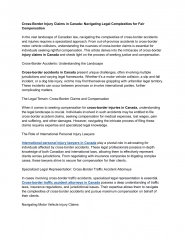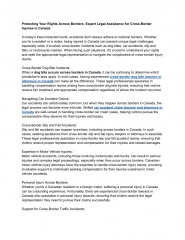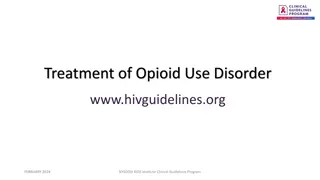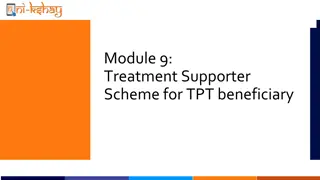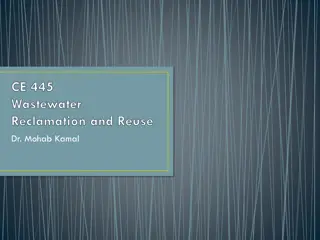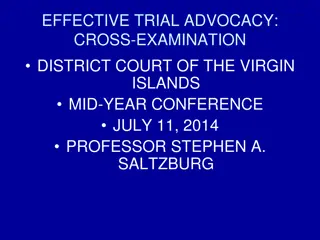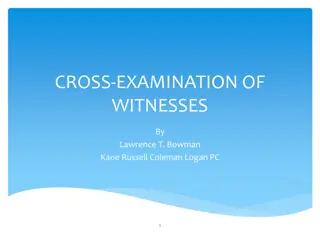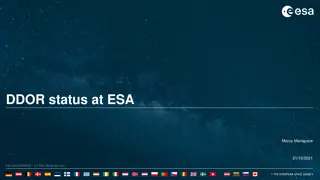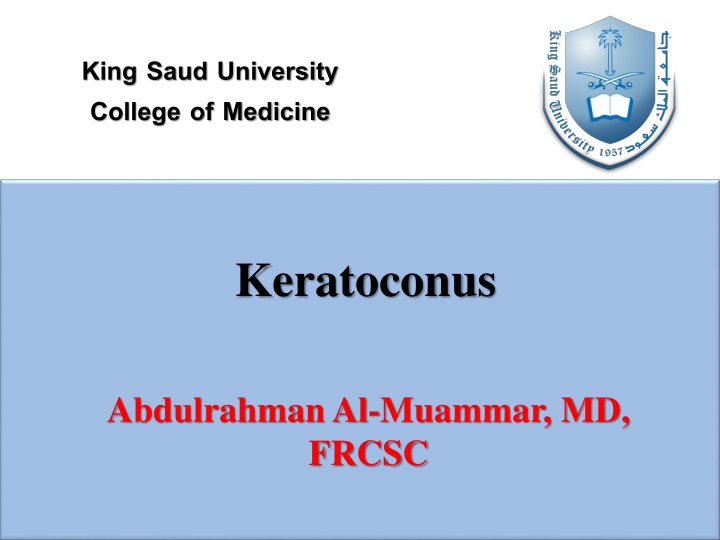
Cornea: Structure and Function
Learn about the anatomy and physiology of the cornea, including its layers, transparency, vascularity, hydration, and essential functions in maintaining eye health. Discover the intricate details that make the cornea a vital part of the visual system.
Download Presentation

Please find below an Image/Link to download the presentation.
The content on the website is provided AS IS for your information and personal use only. It may not be sold, licensed, or shared on other websites without obtaining consent from the author. If you encounter any issues during the download, it is possible that the publisher has removed the file from their server.
You are allowed to download the files provided on this website for personal or commercial use, subject to the condition that they are used lawfully. All files are the property of their respective owners.
The content on the website is provided AS IS for your information and personal use only. It may not be sold, licensed, or shared on other websites without obtaining consent from the author.
E N D
Presentation Transcript
King Saud University College of Medicine Keratoconus Abdulrahman Al-Muammar, MD, FRCSC
Physiologic functions of the cornea Cornea is a transparent avascular connective tissue Act as the primary infectious and structural barrier of the eye Together with the overlying tear film, it provides a proper anterior refractive surface for the eye
Anatomy Anterior surface of the cornea is elliptical with horizontal diameter of 11.5 to 12 mm and vertical diameter of 10.5 to 11 mm Posterior surface of the cornea is circular with an average diameter of 11.5 mm It is about 520 m thick at the center and gradually increases in thickness toward the periphery 670 m Shape of the cornea is prolate-flatter in the periphery and steeper centrally-which creates an aspheric optical system
Anatomy Human cornea consists of 5 recognized layers Epithelium Bowman s membrane Stroma Descemet s membrane Endothelium
Transparency To function as proper anterior refractive surface Avascular Corneal hydration Peculiar arrangement of stromal fibers and extracellular matrix
A vascularity Cornea required energy to maintain its transparency and structure Most actively metabolizing layer are epithelium and endothelium Source of nutrients required for the corneal metabolism are: Oxygen Epithelium derives oxygen from the atmosphere through tear film and through limbal capillaries Endothelium derives oxygen from the aqueous humor Glucose Glucose is the prime energy source 80% from the aqueous 20% from limbal blood vessels Little from the tear film Amino acids Main supply from aqueous humor by passive diffusion
Corneal hydration Water content of normal cornea is 78 % Water content kept constant by a balance of factors Factors which draw water in the cornea Swelling pressure of the stromal matrix Intraocular pressure Factors which prevent the flow of water in the cornea or draw water our of the cornea Mechanical barrier action of epithelium and endothelium Active pumping action of endothelium Evaporation through corneal epithelium Lamellar organization of the stromal fibers
Peculiar arrangement of stromal fibers The stroma differs from other collagenous structures in its transparency precise organization of the stromal fibers in regular lattice Fibrils are small in relationship to the light and do not interfere with light transmission Limited number of cells and crystallins component of cells allow light transfer and minimize light scatter
Refractive function Convex shape Collagen lamella insertion in the limbus Intraocular pressure Smooth anterior surface provided by tear film Corneal hydration to maintain constant refractive index
Keratoconus Common disorder (prevalence of about 50 per 100,000) Positive family history have been reported in 6%-8% PATHOLOGY Histopathologically, keratoconus shows the following: fragmentation of Bowman layer thinning of the stroma and overlying epithelium folds or breaks in Descemet's membrane variable amounts of diffuse scarring
Keratoconus Keratoconus is a degenerative noninflammatory disease of the cornea The prevalence is 1 in 2000 With the current diagnostic technique the prevalence is probably higher Usually the condition start at puberty and progress until the third to fourth decade of life Penetrating/Lamellar keratoplasty may become necessary in 21% of keratoconus patients
The Amsler-Krumeich classification for the grading of keratoconus Stage I Eccentric steeping. Myopis and/or induced astigmatism <5.00 D Mean central K readings <48.00 D. Stage III Myopia and/or induced astig-matism from 8.00 to 10.00 D. Mean central K readings >53.00 D. Absence of scarring. Minimum corneal thickness 300 to 400 m. Stage IV Refraction not measurable. Mean central K readings >55.00 D. Central corneal scarring. Minimum corneal thickness 200 m. Stage II Myopia and/or induced astigmatism from 5.00 to 8.00 D Mean cental K readings <53.00 D Absence of scarring. Minimum corneal thickness >400 m
Treatment options for keratoconus Spectacles. Contact lenses. Phototherapeutic keratectomy. Intrastromal corneal rings. Corneal collagen cross-linking. Phakic intraocular lenses. Keratoplasty.
Spectacles In very early cases, spectacles may provide adequate visual correction. Stage I. Toric contact lenses.
Contact lenses The vast majority of patients wear rigid contact lenses for adequate vision correction. Rigid gas permeable hard contact lens is the most commonly used for keratoconus. Stage I, II, and III. (? Stage IV) Contact lens become a problem Dry eye Allergy Poor fitting
Phototherapeutic keratectomy Can be used in case of advanced keratoconus to reduce contact lens intolerance. While it may be helpful in some cases, PTK may cause keratolysis, increased scarring and ectasia. Stage III and IV.
Corneal collagen cross linking Recently been proposed as a method for stopping the progression of keratoconus. The 5 years results showed that it is safe and effective. Stage I and II. Can be done with intrastromal corneal rings.
Clinical Studies # of Pts # of eyes Mean Follow up Progression of KC in treated eyes Progres- sion of KC in control eyes Post- operative increase in VA Post- operative regression in K value Post- operative regression in RE Study Wollensak et al AJO 2003 22 pts 23 eyes 23.3 (range 3 to47 months) None 70% have reduction Improved By 1.26 lines in 65% In 70% by 2.01 D P=.001 Improved by 1.42 D P=.03 22% Caporossi et al JCRS May 2006 10 pts 10 eyes 3 months None 37% Improved by 3.6 lines P=.00001 Improved by 2.49 D By 2.1 D 44 eyes 12 months None 30% ESCRS 2008 Braun ARVO 2005 22 pts 27 eyes Slightly improved in 65% In 44% by 3.1 D In 44% by 2.14 D 6 months None
Laser refractive surgery (surface ablation) Under research, mainly for stage I Mild keratoconus with no progression in patients who are over age 40. In conjunction with CCX No progression Enough corneal thickness
Phakic intraocular lenses Can be done for keratoconus patients with no signs of progression. Patients who may have good result are those who can be corrected with spectacles. Stage I. (? Stage II) Iris/ angle supported and posterior chamber regular/toric phakic IOL can be used.
Intrastromal corneal rings A method for flattening the cornea that is too steep and making a patient more contact lens tolerant. Good for mild cases who want to improve their present vision with or without spectacles or contact lenses. Stage I,II, and III. (?stage IV). INTACS and Ferrara intrastromal corneal segments.
Outcomes of Intacts treatment for keratoconus Study Eyes Intacs/ Ferrara FU Incision Site Technique VA Change Mean Refractive Change Ibrahim 186 Intacs 5 y Steep meridian Sym or asym (0.25 to 0.45 mm) 85.23% & 87.9% gained lines of UCVA and BCVA K-values improved from 52.53 D TO 48.05 D Colin 100 Intacs 2 y Temporal Sym 80.5% and 68.3% gained lines of UCVA and BCVA, respectively Mean MRSE improved from - 6.93 D to -4.01 D (0.45/0.40 mm) Ertan 118 Intacs 1 y Temporal Asym 81.3% and 73.7% gained lines of UCVA and BCVA, respectively MRSE improved by more than 2.00 D in 70.3% of eyes (0.25/0.45 mm) Kwitko 51 Ferrara 13 mo Steep meridian Sym 84.4% gained lines of UCVA and BCVA MRSE decreased from -6.08 D to -4.55 D (0.20/0.30 mm) Siganos 26 Ferrara 6 mo Steep meridian Sym BCVA improved from 0.37 to 0.60 MRSE decreased from -6.91 D to -1.11 D (0.15/0.35 mm)
Keratoplasty Corneal transplant is the best and most successful surgical option for keratoconus patient who cannot tolerate contact lens. It is the only option for patients who have scarring in the centre of the cornea. BCVA < 20/40. Mainly for stage IV (? Stage III). The results of corneal transplants are excellent in keratoconus patients with an over 97% success rate.
Keratoplasty PKP disadvantages: Long term survival. Invasive procedure. Long visual rehabilitation. Frequent follow up. Topical steroid complications. 50% of patient may need HCL following PKP.
Keratoplasty Intralase enables keratoplasty is one of the advances in corneal surgery Quicker procedure. Quicker recovery. Less astigmatism with better vision.
Lamellar corneal transplant Gaining popularity among corneal surgeon. Slightly safer than a full thickness transplant. Risk of rejection is low which give advantage for long term success. Disadvantages: Quality of vision preferred to be low than those who have undergone full thickness transplant Intralase enabled keratoplasty may lead to better quality of vision by making smooth interface.
KERATOCONUS - STAGE I STAGE II STAGE III STAGE IV NON-PROGRESSIVE NON-PROGRESSIVE Spectacle Contact Lenses Rings Phakic IOL Contact Lenses Rings Phakic IOL Contact Lenses Rings Keratoplasty Contact Lenses Rings Keratoplasty PROGRESSIVE PROGRESSIVE Spectacle Contact Lenses Rings CCX Contact Lenses Rings CCX

![Read⚡ebook✔[PDF] Linking the Space Shuttle and Space Stations: Early Docking Te](/thumb/21519/read-ebook-pdf-linking-the-space-shuttle-and-space-stations-early-docking-te.jpg)
